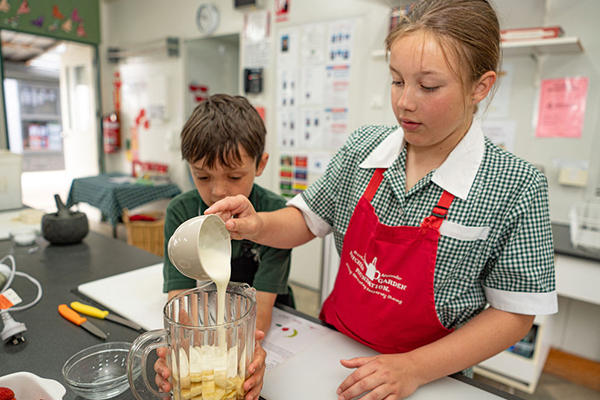Dairy drinks around the world: the globe in a glass

Grab your aprons and a big dollop of adventure because we’re sharing our Top Ten favourite dairy drinks from around the world to celebrate World Milk Day!
Mixing, blending, and sipping our way through this milky menu isn't just about tantalising our taste buds – it's also a fantastic way to nourish our bodies with essential dairy nutrients like calcium, protein and potassium.
After making your dairy delights, use your empty milk cartons to make milk bottle waterers! Members will find this new resource on the Shared Table.
The Stephanie Alexander Kitchen Garden Foundation is lucky to partner with Saputo Dairy Australia (SDA), experts in all things dairy. SDA produces and distributes a delicious range of cheese, milk, cream and yogurt. You’ll probably recognise some of their brands, like Devondale, CHEER, Liddells, Tasmanian Heritage and Mersey Valley.
Get ready to explore the wonderful world of milk and yogurt drinks. Let’s go!
1. First stop: Indonesia.
SUSU JAGUNG MANIS. Sweetcorn kernels are blended with water, milk and salt until smooth; then strained and sweetened for this vibrant yellow drink. Pandan leaves or cinnamon are often added, and susu jagung manis can be served warm or icy cold.

2. Next up: India.
LASSI. A simple, frothy mix of yogurt and water, lassis are enjoyed both sweet and savoury. The namkeen lassi has a dash of pepper and roasted cumin seeds, while the sweet version, metha lassi, often includes a pinch of cardamom or a splash of rosewater. Mango lassi is one of Stephanie Alexander’s favourite breakfasts. Find our recipe here:
3. Onward to Lebanon.
SALEP/SAHLEP/ SAHLEB. This warm cinnamony milk is traditionally thickened with orchid tuber flour, and is often richly scented with cloves and ginger. You’ll find it in cafes, street stalls and homes right across the Middle East.

4. Take a trip to Turkey.
AYRAN. This traditional drink of tangy yogurt mixed with icy cold water and a pinch of salt has many different cultural variations. In Cyprus, ayran (known as ayrani) is made with sheep yogurt; and in Afghanistan lime juice and diced cucumber are added to ayran (known as dogh).
5. Across to Eastern Europe.
RYAZHENKA. This probiotic-packed drink is popular throughout Ukraine, Belarus and Russia. It is made by fermenting slow-baked milk with sour cream, kefir or buttermilk, resulting in a velvety texture and a buttery colour – it's like a sip of liquid gold!
6. Tippel (stroll) to the Netherlands.
ANIJSMELK. The Dutch are obsessed with licorice, so it’s no surprise a popular drink, traditionally enjoyed after ice skating, is warm milk flavoured with aniseed. Milk, aniseeds and honey are simply stirred over a low heat and strained.

7. Merengue to the Dominican Republic.
MORIR SOÑANDO. This refreshing iced drink is made by slowly mixing orange juice into milk sweetened with sugar or honey. Both the milk and orange juice must be cold before combining so the drink doesn’t curdle.
8. Cha cha to Cuba.
BATIDO DE TRIGO. This creamy Cuban milkshake is made with sweetened condensed milk, whole milk, ice and puffed wheat cereal (trigo). Vanilla is often added as well. It makes a delicious breakfast or after-school snack.
9. Let’s make our way to Mexico.
ATOLE. A comforting mug of atole is like a warm blanket for your tummy. It’s made from cornmeal (known as polenta in Australia), milk and a touch of honey or sugar. Atole is sometimes flavoured with vanilla or cinnamon, and the pretty pink atole de guayaba contains fresh guava puree. Delicioso!
10. Finally, we’re heading to Chile.
LECHE CON PLÁTANO. This light, ubiquitous Chilean milkshake is made by blending milk with bananas, sugar and ice – and sometimes a good dollop of cream!

So, there you have it, a whirlwind tour of milky marvels from around the world! Childhood is the best opportunity to build strong bones for life, and peak bone density is reached around age 20-25. Let’s get our spoons stirring and blenders whirring.
Like to learn more about the Kitchen Garden Program? Join a community of early childhood, primary school and secondary school educators all around Australia teaching children and young people how to grow, harvest, prepare and share fresh, seasonal, delicious food.
Learn about the Kitchen Garden Program

< Back to Latest News
